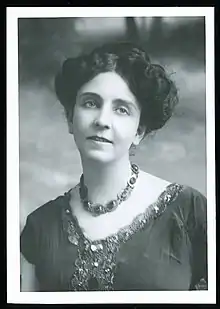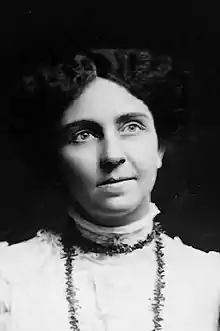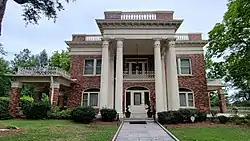Adrienne Herndon | |
|---|---|
 Herndon in 1891 | |
| Born | Adrienne Elizabeth McNeil July 22, 1869 Savannah, Georgia |
| Died | April 6, 1910 (aged 40) Atlanta, Georgia |
| Other names | Anne Du Bignon |
Adrienne Elizabeth McNeil Herndon (1869-1910) was an actress, professor, and activist in Atlanta, Georgia. While admittedly an African American to friends and colleagues, she performed with the stage name Anne Du Bignon. She was one of the first African American faculty at Atlanta University, where she met W. E. B. Du Bois and subsequently worked with him. Herndon and Alonzo Herndon were an influential couple.[1]
Biography
Adrienne Elizabeth McNeil was born on July 22, 1869, in Savannah, Georgia.[2] She is described by historian Rebecca Burns as "short and lithe with a lively manner and sophisticated bearing" "[w]ith her creamy skin, wavy brown hair, and dark eyes, Adrienne moved easily [...] and kept her racial background a secret".[3] She was about five feet tall.[1]
McNeil was an 1890 graduate of Atlanta University's Normal Department, and attended the Boston School of Dramatic Arts (1902-3)[1] and New York City's American Academy of Dramatic Arts.[4] For her final project she performed Anthony and Cleopatra under the stage name Anne Du Bignon, claiming she was French-Creole.[1][3]
At Atlanta University Herndon became "the first director of dramatics and teacher of elocution" from 1895, until her death in 1910.[4] She was one of the first two African American faculty at Atlanta University (the other was George Towns), two years prior to Du Bois.[3] There she organised fundraising and an annual Shakespeare play for the senior class.[4][5]
In January 1904, Herndon made her debut with a solo-performed at Steinert Hall in Boston again using the name Anne Du Bignon.[1] She also sang at recitals.[1]

Herndon supported black suffrage. Du Bois and Adrienne Herndon were colleagues at Atlanta university.[3] In October 1904, Alonzo signed the Ontario Conference led by Du Bois.[6] Adrienne Herndon, in 1905, hosted the "Niagara Movement" organized by Du Bois.[3] She participated in Du Bois's Wheat Street Baptist Church demonstration on November 30, 1905, for the "southern movement" by joining him on the platform.[6] During the Atlanta Riots two of Alonzo's employees were attacked and killed.[6] The Tuesday morning after the rioting, Herndon [note 1] along with Reverend Henry H. Proctor met with the city mayor and chief of police to discuss safety for victims and justice for the rioters.[6]
Adrienne McNeil married Alonzo Herndon[4] in 1894.[3] Before she agreed to marry him, he had to promise to support her theater career.[1] In 1897 Adrienne and Alonzo Herndon had a son, Norris Bumstead Herndon.[7]

The Herndon Home, she designed without plans but worked closely with a team of black craftsmen.[8] Unfortunately Adrienne died of Addison's disease just when the home that she had designed to be their "first real home" was nearing completion, on April 6, 1910.[note 2][9][10]
Norris Herndon, a 1919 graduate of Atlanta University, developed his father's insurance company from $1 million to $54 million in assets.[7][11] In 1947 Norris Herndon established the Herndon Foundation which maintains the Herndon Home.[7] He transformed the house into a museum in 1973.[8] It was declared a U.S. National Historic Landmark in 2000.[9]
Notes
Sources
- 1 2 3 4 5 6 7 Merritt, Carole (2002). The Herndons : an Atlanta family. Athens, Ga. [u.a.]: University of Georgia Press. ISBN 978-0820323091.
- ↑ "Register of the Herndon Family Collection".
- 1 2 3 4 5 6 Burns, Rebecca (2009). Rage in the Gate City : the story of the 1906 Atlanta race riot (Rev. ed.). Athens, Ga.: University of Georgia Press. ISBN 978-0820333076.
- 1 2 3 4 Peterson, Bernard L. (1997). The African American theatre directory : 1816-1960 : a comprehensive guide to early black theatre organizations, companies, theatres, and performing groups (1. publ. ed.). Westport, Conn. [u.a.]: Greenwood. p. 21. ISBN 978-0313295379.
- ↑ Nathans, Heather S.; Godfrey, Mimi (2011). Kahn, Coppelia (ed.). Shakespearean educations : power, citizenship, and performance. Newark: University of Delaware Press. pp. 222–223. ISBN 978-1611490282.
- 1 2 3 4 Capeci, Dominic J. Jr.; Knight, Jack C. (November 1996). "Reckoning with Violence: W. E. B. Du Bois and the 1906 Atlanta Race Riot". The Journal of Southern History. 62 (4): 727. doi:10.2307/2211139. JSTOR 2211139.
- 1 2 3 Nielsen, Euell (2016-03-09). "Herndon, Norris Bumstead (1897–1977) | The Black Past: Remembered and Reclaimed". www.blackpast.org. Retrieved 20 October 2016.
- 1 2 Winn, Alisha (Spring 2014). "Black Entrepreneurship: Contradictions, Class, and Capitalism". Journal of Business Anthropology. 3 (1): 79–108. doi:10.22439/jba.v3i1.4315.
- 1 2 Frank J. J. Miele; John Sprinkle; Patti Henry (November 1999). "National Historic Landmark Nomination: Herndon Home" (pdf). National Park Service. and Accompanying 6 photos, of Herndon and family and of exterior and interior of mansion, from c.1910, c.1915, 1998 (32 KB)
- ↑ Kolin, Philip, ed. (2007). Contemporary African American women playwrights : a casebook. London: Routledge. ISBN 978-0415978262.
- ↑ Chenault, Wesley; Center, Stacy Braukman, Atlanta History (2008). Gay and lesbian Atlanta. Charleston, SC: Arcadia Pub. pp. 20–21. ISBN 978-0738553771.
{{cite book}}: CS1 maint: multiple names: authors list (link)
Further reading
- Carole Merritt (2004). "African Americans in Atlanta: Adrienne Herndon, an Uncommon Woman". Southern Spaces. 2004. doi:10.18737/M7XP4B.
- Clarence Albert Bacote, The story of Atlanta University: a century of service, 1865-1965, Atlanta University, 1969.
- "Adrienne McNeil Herndon".
- "Adriene Hendon Actress and Designer".
- Henderson, Alexa Benson (2016). "The Work and Legacy of Adrienne Elizabeth McNeil Herndon at Atlanta University, 1895–1910". Phylon. 53 (1): 80–101. ISSN 0031-8906. JSTOR phylon1960.53.1.80.